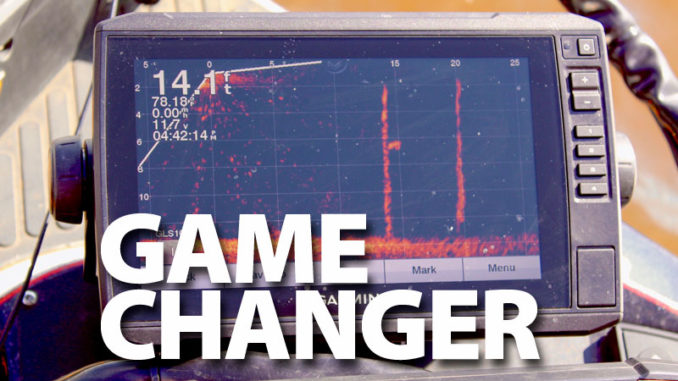
New LiveScope gives anglers extreme advantage in catching fish.
I lost count at 15 the number of times Nick Young used the word “unbelievable” as he talked about and demonstrated the new LiveScope technology that has netted unbelievable interest in the crappie-fishing world.
“The greatest thing about LiveScope is that it can be set to be forward facing. It lets you see the structure and the fish before you even get to them, 10 to 20 feet out in front of the boat,” Young said. “That is important; you get to present the bait better because you see right where the fish is sitting in relation to the structure. There’s no more guessing whether there is structure or fish there and exactly how deep they are. It’s unbelievable.”
Unbelievable technology
“Another thing, it allows you to put the bait right in front of the fish and keep it there,” he said. “Crappie are finicky, and if you are looking at traditional sonar, most of the fish might show as 6 feet deep. You fish for those, but there also may be fish 4 feet deep or 8 feet deep.
With LiveScope, you can see all of those fish and make sure your bait is exactly the right depth. That’s because you can even see your bait going down. It’s not a guessing game anymore. It even lets you see the size of the fish before you fish for them.”
You probably already know what he said next.
“It’s unbelievable,” said Young, a guide on Lake D’Arbonne.
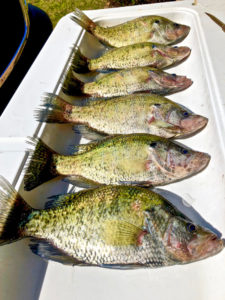
While the LiveScope, a product of Garmin, is probably easier to use in deeper water, Young said it can be used anywhere.
“You can see fish on a live cypress tree in 3 foot of water without a problem. You can basically tell whether it’s a smaller fish or a larger fish, and you can present your lure to it before spooking it because, once again, you see the fish before you even get close to it,” he said. “We fished for spawning fish on the trees and out on the flats from 3 to 20 feet deep and have had the same results using LiveScope.”
The equipment works in pretty much any type of conditions: clear water, muddy water, still water or current, Young said. “The only problem comes if the wind is blowing too hard and you try to fish with your boat bouncing in big waves. That makes it hard to get a clear picture because the transducer is bouncing up and down.
“Don’t get me wrong; it isn’t the end all of crappie fishing,” he said. “You can still catch plenty without it. It’s just another tool, but it’s a good tool. There are times when you can’t use it, like when the fish are scattered and you are long-lining, because then the lures are out behind the boat.”
Young looks forward to using the LiveScope in the summer because the fish scatter more and are often hard to find and catch. This technology will help make sure he can present bait at exactly the right depth, “right on the fish’s nose” as he said.
“That’s really important once the water temperature hits 92 degrees, because they get a little lethargic. They won’t chase a bait like the rest of the year,” he said. “But they’ve gotta eat. At least with LiveScope, you know for sure there are fish there and exactly how deep they are and how they are relating to tops and stumps and other structure.”
How difficult is this technology to use?
“Not hard whatsoever,” Young said. “It’s the easiest-to-use depth finder I’ve ever had. You take it out of the box, hook it into the unit, and within a couple of hours of use, you can start understand what you are seeing. After about two days, you can start telling the difference between big fish and little fish, and you can learn quickly what kind of fish you are seeing, simply by the way they relate to the structure. It’s been the best learning tool I’ve ever had in more than 20 years of fishing.”
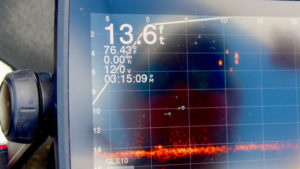
Wait, there is a catch.
“For everything the LiveScope will do, it will not catch fish for you,” Young said. “If they don’t want to bite, it doesn’t matter what you do. I tell my clients all the time, just because we are seeing all kinds of fish doesn’t mean we will catch everything we see. There is no ‘Bite Button’ on the LiveScope that you can just push and make crappie bite. The fish still makes the ultimate decision.”
When fishing is good, Young fishes five to seven days a week, and for the most part, it has changed the way he fishes. It has also helped him get younger fishermen more interested in fishing.
“Normally, when I take clients with kids and we are catching fish, it’s fun when the fish are biting, but today’s youngsters get bored fairly quickly,” Young said. “But this is a game changer. Kids love watching the LiveScope and seeing everything going on down under the boat. Most kids are into video games, and it’s just like a video game, only with live action. They’ll sit glued to it, watching when you pull up to a stump, lower the bait down and stop it. When a fish starts swimming up to bite the bait and then he hits it, they go crazy. They love it.”
It isn’t just the kids, either. How could any fisherman not get a bit giddy doing that?

Young not only guides full-time on Lake D’Arbonne, but in addition to taking you fishing, he will teach you the LiveScope basics, if you are interested.
“One of the coolest things I’ve seen is when you have a fish swim up to the bait and look it over, then just sit there,” Young said. “Sometimes they’ll swim back away, but if you can get two fish looking at it, one of them is going to bite it every time. It’s kind of like they don’t really want it, but they aren’t going to let the other one get it first.”
“Like I said, it is just a tool, but it’s an important one,” he said. “I think it will do more to change crappie fishing than anything since the invention of the electric trolling motor.”
Unbelievable.
You can contact Nick Young at D’Arbonne Lake Guide Service on Facebook, by email at Nicholas.Young22@aol.com or by calling 318-243-8646.
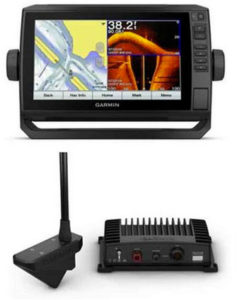 So, what’s the cost?
So, what’s the cost?
A new LiveScope system for your boat can cost between $3,500 and $6,000, based on the size and complexity of your unit’s display screen.
A good, basic 9-inch unit is Garmin’s ECHOMAP Plus 93sv Panoptix Livescope system Chartplotter with Panoptix Livescope System. The unit and transducer, lake data card, cables and cords, taxes and installation runs around $3,500. The price goes up with larger units, but if you can install it yourself, you can also save a few hundred dollars.
Earlier this year, the price wasn’t as big as a concern as the availability. The units have been so popular that they were on back order from most vendors for four to six weeks.
That doesn’t seem fair!
Welcome to Louisiana Sportsman Jeopardy.
Category: Crappie Fishing for $400
Answer: “Well, that doesn’t seem fair.”
Question: What is The Panoptix LiveScope scanning sonar system?
That is correct! Okay, it hasn’t hit the popular television show “Jeopardy” yet, but the first response to hearing about or seeing Garmin’s new LiveScope depth finder technology in action is almost always, “that doesn’t seem fair.”
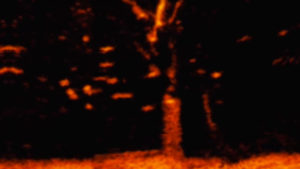
Why? This “depth finder” doesn’t just let you see the bottom, how deep the water is, water temperature, fish signatures, etc., like other depth finders. It shows structure and fish in real time. You can even see the fish in motion, swimming around a treetop or stump. Wait, it gets better. The big red “blips” are the big fish. The little red “blips” are small fish.
Wait, we aren’t finished. When you drop your jig in the water, you can even see it sink down on the screen. You can lower it right in front of the fish and actually see the fish swim up and eat the bait. No kidding.
That really doesn’t seem fair. But only if you are a fish. Fishermen have taken to it like a duck to water. The best descriptive comparison I can come up with is that the view you get is much like that of the 3D ultrasound that doctors use to show pregnant women their unborn babies. You can see the face, the fingers, the feet, etc. One side note here: the LiveScope is NOT good enough YET to let you know if the crappie is a boy or a girl.
I’ve got to admit, using LiveScope isn’t as easy as it seems. Like any electronics, you have to learn what it can and can’t do, learn to fine tune it for different conditions and then spend lots of time looking at the screen to know what you are seeing.
The first time I fished in the front of the boat with a LiveScope, my partner pointed out a treetop full of fish, showed me how to watch the jig go down and then said, “Look, one is swimming up to your jig”. The fish did swim up to the jig, grabbed it and started swimming off.
“Aren’t you going to catch him,” my partner asked.
I was so busy watching everything on TV, I forgot I was fishing and actually had a real fish on the line.
Perhaps the most remarkable story I’ve heard first-hand about the capability of the LiveScope came in this spring’s Crappie Masters Louisiana State Championship on Lake D’Arbonne. The big fish of the tournament was a 2.60 pound crappie. The way it was caught was remarkable.
The fisherman recounted the story at the weigh-in. He had seen the big crappie on the LiveScope and fished for it for several minutes when it finally bit, but hit short. He only had the fish on for a few seconds and it got off. He continued to watch the fish and followed it as it swam about 50 feet to another treetop and stopped. He waited a few minutes, then dropped the jig back down in front of the slab. Thump. It bit again and this time he landed it.
Learning the hard way
Nick Young didn’t have to actually fish with a LiveScope to know he needed one. He learned that when he walked off the platform of the 2019 Crappie Masters Louisiana State Championship on Lake D’Arbonne earlier this spring with the third-place check in hand.

As defending champions, that wasn’t the check he and his dad, Jock, wanted. It became painfully obvious the two teams that finished in front of him had an advantage. They had LiveScope on their boats, and both credited it with helping them find bigger fish and staying on them until they bit.
”The last day, we fished 20 to 50 yards away from each other on the same stretch of timber,” Nick Young said. “I was having to catch every fish I could, and every once in a while, come up with a big one. They were using the LiveScope and were fishing tree to tree, only stopping when they saw the big ones on the scope. I was having to guess at whether they were 6 or 7 or 8 feet deep. They were able to drop the bait right on the fish’s nose.
“We only had about three hours to fish before the wind came up and blew us off the spot. That concentrated time on the big fish that they had was the difference. While I was catching and culling, they were basically just catching big ones. I caught lots more fish, but they caught more big ones. That advantage put them over the top.”
How sure was Young that was the difference? He went home and ordered his new LiveScope that night before he went to bed.


